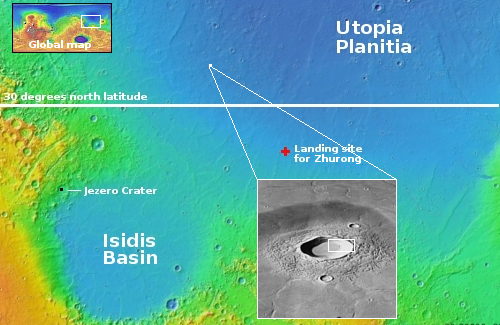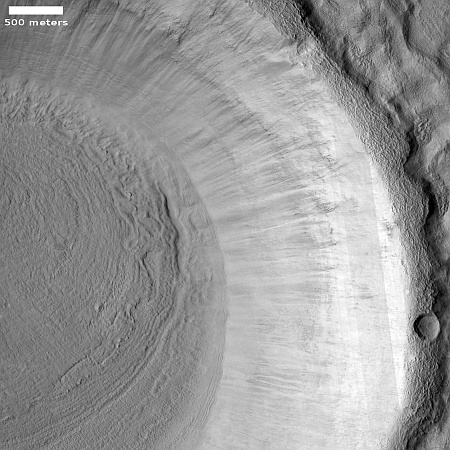A Martian splash crater in the northern lowland plains
Cool image time (necessary when there is no real space news to report)! The picture to the right, cropped, reduced, and sharpened to post here, was taken on June 29, 2023 by the high resolution camera on Mars Reconnaissance Orbiter (MRO). It shows what the scientists label as “steep crater walls.”
And the interior slopes of this 5-mile-wide unnamed crater are steep, about 600 feet high and descending at a grade of 10 to 13 degrees, getting steeper as you go down. In fact, the floor of the crater itself continues that slope downward to the west until it reaches the base of its western interior wall. For some reason the glacial material within it is piled up higher on its eastern end.
The dark streaks on the crater interior walls are either slope streaks or recurring slope lineae, with the former appearing somewhat randomly and the latter seasonal in nature. Both remain unexplained unique phenomenons of Mars. This new picture was likely a follow-up of a January 2014 MRO picture to see if anything had changed in the past decade.
To my eye it is difficult to detect any changes, but I am not looking at the highest resolution version of the picture. The lack of changes suggests the streaks are seasonal lineae, as both images were taken in the northern spring and the streaks in both appear much the same.

The rectangle inside the inset on the overview map to the right indicates the area covered by the picture above. The location is in Utopia Basin in the northern lowland plains of Mars. The latitude, 34 degrees north, explains the splashy nature of the apron around this crater. This is a region with lots of near surface ice impregnated within the soil. When the impact occurred that created the crater, that ice melted, flowed for a very short time, and then froze in the splash pattern we now see.
Whether that formation process has anything to do with the streaks remains unknown. The steepness of the walls is certainly an important factor, but that doesn’t really explain the actual process that creates these streaks, which though resembling avalanches do not change the topography and have no debris pile at their base.
On Christmas Eve 1968 three Americans became the first humans to visit another world. What they did to celebrate was unexpected and profound, and will be remembered throughout all human history. Genesis: the Story of Apollo 8, Robert Zimmerman's classic history of humanity's first journey to another world, tells that story, and it is now available as both an ebook and an audiobook, both with a foreword by Valerie Anders and a new introduction by Robert Zimmerman.
The print edition can be purchased at Amazon or from any other book seller. If you want an autographed copy the price is $60 for the hardback and $45 for the paperback, plus $8 shipping for each. Go here for purchasing details. The ebook is available everywhere for $5.99 (before discount) at amazon, or direct from my ebook publisher, ebookit. If you buy it from ebookit you don't support the big tech companies and the author gets a bigger cut much sooner.
The audiobook is also available at all these vendors, and is also free with a 30-day trial membership to Audible.
"Not simply about one mission, [Genesis] is also the history of America's quest for the moon... Zimmerman has done a masterful job of tying disparate events together into a solid account of one of America's greatest human triumphs."--San Antonio Express-News
Cool image time (necessary when there is no real space news to report)! The picture to the right, cropped, reduced, and sharpened to post here, was taken on June 29, 2023 by the high resolution camera on Mars Reconnaissance Orbiter (MRO). It shows what the scientists label as “steep crater walls.”
And the interior slopes of this 5-mile-wide unnamed crater are steep, about 600 feet high and descending at a grade of 10 to 13 degrees, getting steeper as you go down. In fact, the floor of the crater itself continues that slope downward to the west until it reaches the base of its western interior wall. For some reason the glacial material within it is piled up higher on its eastern end.
The dark streaks on the crater interior walls are either slope streaks or recurring slope lineae, with the former appearing somewhat randomly and the latter seasonal in nature. Both remain unexplained unique phenomenons of Mars. This new picture was likely a follow-up of a January 2014 MRO picture to see if anything had changed in the past decade.
To my eye it is difficult to detect any changes, but I am not looking at the highest resolution version of the picture. The lack of changes suggests the streaks are seasonal lineae, as both images were taken in the northern spring and the streaks in both appear much the same.

The rectangle inside the inset on the overview map to the right indicates the area covered by the picture above. The location is in Utopia Basin in the northern lowland plains of Mars. The latitude, 34 degrees north, explains the splashy nature of the apron around this crater. This is a region with lots of near surface ice impregnated within the soil. When the impact occurred that created the crater, that ice melted, flowed for a very short time, and then froze in the splash pattern we now see.
Whether that formation process has anything to do with the streaks remains unknown. The steepness of the walls is certainly an important factor, but that doesn’t really explain the actual process that creates these streaks, which though resembling avalanches do not change the topography and have no debris pile at their base.
On Christmas Eve 1968 three Americans became the first humans to visit another world. What they did to celebrate was unexpected and profound, and will be remembered throughout all human history. Genesis: the Story of Apollo 8, Robert Zimmerman's classic history of humanity's first journey to another world, tells that story, and it is now available as both an ebook and an audiobook, both with a foreword by Valerie Anders and a new introduction by Robert Zimmerman.
The print edition can be purchased at Amazon or from any other book seller. If you want an autographed copy the price is $60 for the hardback and $45 for the paperback, plus $8 shipping for each. Go here for purchasing details. The ebook is available everywhere for $5.99 (before discount) at amazon, or direct from my ebook publisher, ebookit. If you buy it from ebookit you don't support the big tech companies and the author gets a bigger cut much sooner.
The audiobook is also available at all these vendors, and is also free with a 30-day trial membership to Audible.
"Not simply about one mission, [Genesis] is also the history of America's quest for the moon... Zimmerman has done a masterful job of tying disparate events together into a solid account of one of America's greatest human triumphs."--San Antonio Express-News


